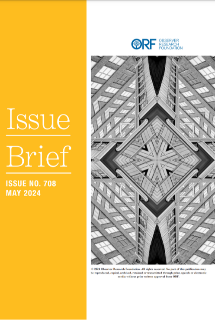
Over decades, seven coronaviruses have been known to infect humans and cause respiratory diseases. Four of them cause mild upper respiratory tract infections. Prior to the current pandemic, there have been two instances where the coronavirus led to disease and death on a large scale. The year 2002 saw the spread of the SARS (severe acute respiratory syndrome) epidemic caused by SARS-CoV while the MERS (Middle East respiratory syndrome) epidemic caused by MERS-CoV occurred in 2012. The origin of most of the coronaviruses in nature can be traced to bats while some have originated from rodents. The virus can get transmitted to humans either directly or via an intermediate host like civets (in SARS) and dromedary camels (in MERS).
The current pandemic of COVID-19 caused by SARS-CoV2 began in 2019 and has affected almost every country in the world in the form of multiple waves leading to deaths, disability, and collapse of the healthcare systems. SARS-CoV2 is the seventh coronavirus known to infect humans.
The virus can get transmitted to humans either directly or via an intermediate host like civets (in SARS) and dromedary camels (in MERS).
Mutants and Variants of Concern (VOC)
Mutations are a part and parcel of the life cycle of any virus. They occur with an ‘intent’ of increasing the survival of the virus either by evading immune attack or by increasing transmissibility and virulence. The persistence of a mutation usually occurs as a result of natural selection if it offers significant survival advantage. A virus that harbours a mutation is known as a mutant. This term is often used interchangeably with ‘variant’. Strictly speaking, ‘variant’ is the term given to the set of genes (genome) inside the virus that carry the mutation. If the mutation leads to a significant change in the physical attributes like structure, virulence, transmissibility or immune evasion, then the virus is labelled as a new ‘strain’ or a ‘variant of concern’. SARS-CoV2 virus is 80 percent similar to the SARS-CoV virus and 50 percent similar to MERS-CoV virus with respect to the genetic sequence. This implies that SARS-CoV2 is a new ‘variant’ in the family of coronaviruses but is genetically closer to SARS-CoV as compared to the MERS virus. The World Health Organisation (WHO) has designated five VOCs for the SARS-CoV2 virus viz. Alpha, Beta, Gamma, Delta, and the recent Omicron variant. All other variants with minor mutations are known as Variants of Interest (VOI), and are under constant monitoring for further mutations.
If the mutation leads to a significant change in the physical attributes like structure, virulence, transmissibility or immune evasion, then the virus is labelled as a new ‘strain’ or a ‘variant of concern’.
Omicron, Delmicron, Stealth Omicron and more
The first case of the fifth VOC was reported to WHO from South Africa on 24 November 2021 as variant B.1.1.529. It was designated as Omicron on 26 November 2022, and since then has rapidly spread across most of countries causing another wave of COVID-19. The evidence from gene sequencing methods and AI-based models have shown that the Omicron variant has more than 30 mutations in the major S (spike) protein responsible for virus entry into cells as well as in the non-structural proteins. The high number of mutations in this major structural protein makes this variant significantly different as compared to its predecessor, the Delta variant. The Omicron variant is 10 times more contagious than the original SARS-CoV2 virus and twice as infectious as the Delta variant. It renders the person prone for higher risk of reinfection and is twice as likely as the Delta variant to evade vaccine immunity. Fortunately, the new mutations have negatively affected the virulence leading to reduced risk of severe disease and death. This was an unexpected clinical finding given the increased transmissibility and ability to tackle vaccine immunity.
The Omicron variant is 10 times more contagious than the original SARS-CoV2 virus and twice as infectious as the Delta variant.
The spread of Omicron variant has led to the resurgence in COVID-19 cases in countries where Delta variant cases were highly prevalent. Such twin peaks of different variants have been termed by many as ‘Delmicron’ although it is not a separate variant of the virus. A more concerning development is the spread of a subset of Omicron termed BA.2. Omicron variant has been recently divided into three subsets viz. BA.1, BA.2 and BA.3. BA.1 is the original Omicron variant while BA.2 represents a slightly mutated version. It is also known as ‘Stealth Omicron’ as it may go undetected even by the current RT-PCR tests. Studies from India have shown that BA.2 infections are dominant in symptomatic cases of Omicron. A new variant (B.1.640) termed unofficially as ‘IHU’ has been reported from France and is currently under analysis as a variant of interest (VOI). Given the current pace of mutations and variant formation, it is logical to assume that there will be more variants of SARS-CoV2. The question remains whether the future variants would be more lethal or harmless.
Are the vaccines effective against Omicron?
The COVID-19 pandemic witnessed the development of multiple vaccines at an unimaginable speed and production on an unprecedented scale. There are 140 vaccines in the phase of clinical development and another 194 in the pre-clinical phase as of 21 January 2022. However, only a handful of them are in current use and have been administered to millions of individuals. A recent systematic review and meta-analysis of vaccine effectiveness showed that all the current vaccines show reduced neutralisation of Omicron variant as compared to Delta and the earlier variants. The degree of neutralisation ranges from -4.3 folds to none as compared to the original strain while it ranges from -2.1 folds to none as compared to Delta. It was also observed that booster doses of all vaccines were effective in eliciting a sustained (3 to 133 folds) neutralisation response. Current vaccines, therefore, are less effective against Omicron but the booster doses provide enhanced immunity against it. It seems that booster doses at regular intervals is the answer to the variant issue unless the virus goes away or a new vaccine is produced that can provide lasting immunity across all variants.
Role of Open Reading Frames (ORF): The many unknowns of coronavirus
The coronavirus consists of four structural proteins (S, E, M, N), 16 non-structural proteins (nsp 1-16), and 11 accessory proteins named ORF. The exact functions of ORF proteins are yet unknown but they play an important role in manipulating the host immune response to the infection that can affect the clinical symptoms and complications directly. Recent studies have highlighted the correlation between ORF mutation prevalence and severity of infection in various continents. Most of the current vaccines and therapeutic drugs are targeted against structural proteins and viral enzymes. Targeting the accessory ORF proteins is an attractive target for future vaccines and drugs.
A recent systematic review and meta-analysis of vaccine effectiveness showed that all the current vaccines show reduced neutralisation of Omicron variant as compared to Delta and the earlier variants.
Can we beat Omicron? – Thor to the rescue!
Molnupiravir (named after the famous hammer ‘Mjölnir’ of the Norse god Thor) is currently the only antiviral available in India that is effective against Omicron. Its initial approval against COVID-19 infection by Delta variant came after the multicentre MOVe-OUT study, which showed reduced death and hospitalisation if started within 5 days of symptoms. It has been now shown that Molnupiravir is highly effective against the Omicron variant too. The Drug Controller General of India (DCGI) has approved the drug for treatment of COVID-19 infection. However, the Indian Council of Medical Research (ICMR) has not recommended its use citing concerns about its teratogenicity, mutagenicity, cartilage toxicity, and weak evidence based on the MOVe-OUT study. However, the National Institute of Health (NIH), USA has recommended its use in its recent guidelines. They have advised that the drug should be avoided in pregnant patients or those planning for pregnancy. They have also specifically mentioned that there is negligible risk of mutagenicity or genotoxicity with this drug. Based on the available evidence, there appears to be no harm in prescribing this drug for non-hospitalised patients with mild COVID-19 infection except pregnant patients.
Pfizer’s Paxlovid (combination of Nirmatrelvir and Ritonavir) has been approved against Omicron but is yet to be available in the Indian market. It has a higher efficacy than Molnupiravir and its production will soon begin in India under the UN-backed Medicines Patent Pool (MPP).
Based on the available evidence, there appears to be no harm in prescribing this drug for non-hospitalised patients with mild COVID-19 infection except pregnant patients.
Amongst the monoclonal antibodies, it has been shown that Bamlanivimab and the Rockefeller University molecules (C144 and C135) are not effective against Omicron. Sotrovimab is the only effective antibody against this variant. Although it was predicted that the REGN-CoV2 antibody cocktail will be effective against Omicron infection, a recent study demonstrated that the variant is resistant to this drug. It would thus be wise to confirm the type of variant before blindly procuring and/or treating the infection with these expensive medications.
Think like a virus – From pandemic to endemic
To predict the end of this pandemic, one needs to think like a virus would. Owing to the rising pressure of mass vaccination, rampant use of newer drugs, and natural immunity acquired by those previously infected, the virus will be ‘forced’ to mutate rapidly. The newer mutations will help the virus to survive, spread, and evade immune attack but will also lead to further waves of infection. There are three hypothesised trajectories of the current pandemic. The most worrisome scenario, albeit unlikely, is where the virus continues to acquire large mutations causing increased hospitalisations and/or deaths. This may be prevented by ensuring a uniform pace in the mass vaccination programmes around the world. Introducing fourth or fifth booster shots in some countries when the others have not completed even one gives space for the virus to mutate. The most likely path is the one where the pandemic will assume a seasonal epidemic pattern similar to the influenza virus, thus, necessitating regular booster jabs. The last trajectory is towards endemicity where the virus evolves into a harmless bug like most of the previous coronaviruses (except SARS and MERS) and cause nothing more than a common cold.
The growing frustration among the public and the economic crises in the last two years have led to lifting of many restrictions and leniency amongst safety precautions across the globe. Until we are sure of the trajectory that the virus follows, it is wise to protect ourselves by following public safety measures and get vaccinated as per the current recommendations. We may be fed up of fighting this pandemic but it looks like the virus is here to stay.
The views expressed above belong to the author(s). ORF research and analyses now available on Telegram! Click here to access our curated content — blogs, longforms and interviews.




 PREV
PREV


